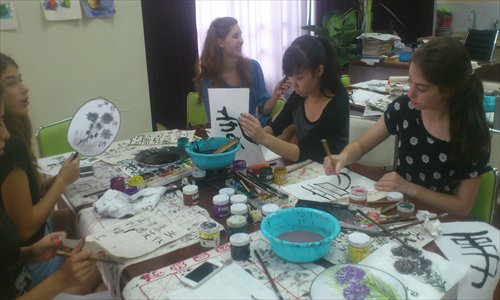

Foreign students write Chinese calligraphy during this year's Shanghai International Friendly City Youth Camp.
During the summer holiday, as many Shanghai students go abroad to attend different summer schools and camps abroad, many foreign youngsters come to Shanghai for the 2014 Shanghai International Friendly City Youth Camp, which ran this year from July 16 to July 29.
The Shanghai Municipal Education Commission started the camp in 2009 to encourage a dialogue among young people in Shanghai and its international friendly cities, and to show off Shanghai as a metropolis. Over the past five years, more than 400 students and teachers from over 20 cities have visited Shanghai.
"We arrange diverse lessons and activities for them while we charge nothing. And during the camp in Shanghai, their accommodation and dining are all free," said Xu Yue, who works for the International Education Association Shanghai, which helps organize the camp.
This year, 121 students from 17 cities came to Shanghai for the camp. They are from Queensland, Australia; Quebec, Canada; Zagreb, Croatia; Espoo, Finland; Bombay, India; Haifa, Israel; Nagasaki, Japan; Busan, Korea; Jalisco, Mexico; Rotterdam, the Netherlands; Dunedin, New Zealand; St. Petersburg, Russia; KwaZulu Natal, South Africa; Basel, Switzerland; Chiang Mai, Thailand; the Rhône-Alpes region in France and Liverpool in the UK.
During their two weeks in Shanghai, the students stayed in the dormitories of the No.2 High School of East China Normal University, which is one of the most prestigious high schools in Shanghai. There, they learned Chinese language and culture. They also went to Oriental Land, which is the biggest youth after-school activities base in China, to participate in different activities like dragon-boat racing. They also visited nearby Zhouzhuang, a well-known river town in China.
Welcome to Shanghai
For most of the students, this was their first time to Shanghai. "I saw Shanghai on TV when I was young and I always thought it was a good city. But the direct image of a city is more impressive than any video or photograph," said Jin Hyong-min, a student from Korea.
"I never realized that Shanghai is so big and is the fourth largest port in the world," Jin said.
Jin studies at Hae Un Dae Tourism High School, where he majors in cooking. He said that the biggest reason that he came to Shanghai to attend the camp was to experience Chinese cooking and dining culture.
Although Chinese cooking lessons were not on the itinerary, Jin said he loved the camp's other activities. "I loved the kung fu lesson," Jin said. "In Korea, every child learns tae kwon do. It requires the learner to be aggressive and to knock others down. While Chinese kung fu like tai chi is more peaceful and relaxed. I appreciated that a lot."
Beh Van Oost Ispael, from Israel, most enjoyed learning the proper way of making tea. "Actually, I love the taste of Chinese tea, and I bought some Chinese tea in Thailand when I traveled there, but I never knew how to make Chinese tea. So this time is a good opportunity for me. Now I know the process. It seems a bit complicated, but interesting!"
The Israeli said he has tea leaves and a tea set at home and can now make this stuff "start functioning."
Mukka Ala Jaaski came from Espoo, Finland. In the view of this 18-year-old, writing means holding something like a pen, but here in Shanghai, he learned how to write Chinese calligraphy with a brush.
"It's a bit uncomfortable for me because the whole way of holding a brush is totally different from holding a pen," he said.
Lin Jiejun is a teacher in the international department of the No.2 High School of East China Normal University. He is the teacher-in-charge who arranges the lessons that the foreign students take during the camp.
He told the Global Times that he arranges Chinese tea making, Chinese knot knitting, Chinese calligraphy, Chinese painting and kung fu for these foreign students. Each activity represents a specific part of Chinese culture.
Compared with the activities he arranged for foreign students in past years, Lin said this year he arranged several lessons that would leave the students with something they could take back home.
"It's nice that we let foreign students experience Chinese culture and it's much better if we can let them take back something they made by themselves," Lin said. "They could keep a bit of Chinese culture in their bedrooms or present what they made to their friends or parents as gifts. It's more meaningful and could influence more people in the long run," Lin said.
So Lin bought picture frames to help the students keep their paintings and calligraphy. He bought many fans and asked students to write and paint their ideas on the fans. "It's hot and the fans are useful," Lin said.
He hoped that many years later, the things the students made in Shanghai will leave them with a beautiful memory of the city as well as the country.
Copyright ©1999-2018
Chinanews.com. All rights reserved.
Reproduction in whole or in part without permission is prohibited.